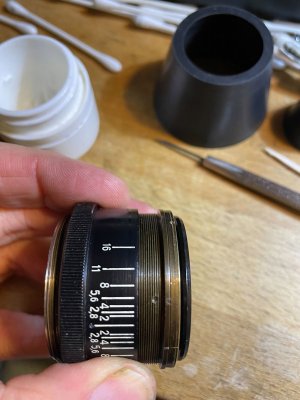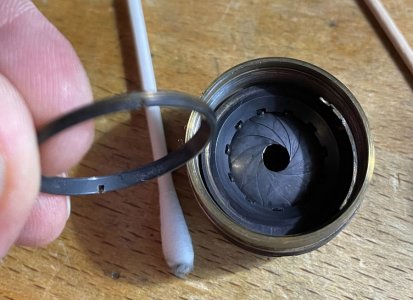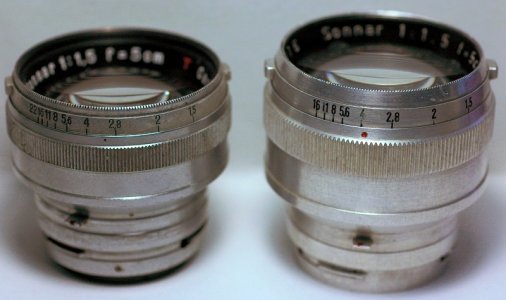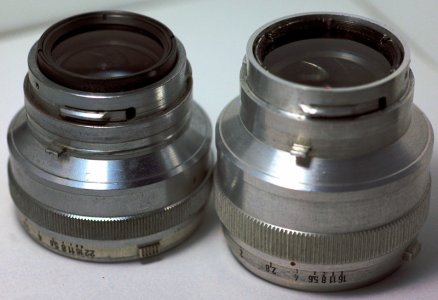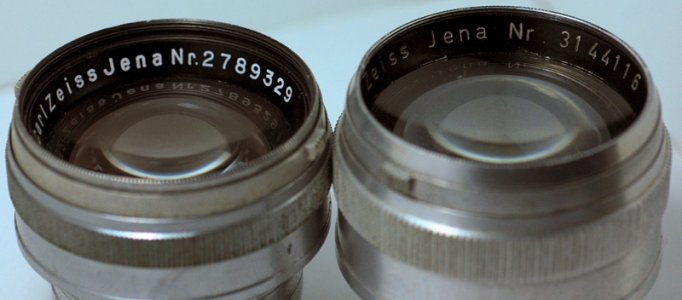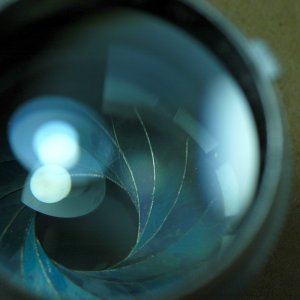On this particular ZK: I had to shim it the same way as I do most Jupiter-3 lenses for the Leica. I had to increase the shim. It was sent to me from Australia as the focus was off on the Leica. Got it all Cleaned/lubed/adjusted, made an offer for the lens which was accepted. I've seen ZK Sonnars with a lot of problems, including the focus index being at a 90degree angle from normal. Most required adjusting the shim, make it thicker.
The regular production LTM Zeiss Sonnars are usually accurate wide-open across the full focus range. I suspect this was done by moving the rear triplet in slightly closer to the front section.
The regular production LTM Zeiss Sonnars are usually accurate wide-open across the full focus range. I suspect this was done by moving the rear triplet in slightly closer to the front section.
TenEleven
Well-known
My 1948 ZK has perfect focus on the LTM standard and the lens was set to 51.6mm without me having to do anything. This was already apparent from the time I bought it as it was set in a Zeiss manufactured helical. (distance in 'm', stopper screw present).
However both the aperture and distance markings are 180 from normal when mounted in a Camera. I assume that this means the lens was intended for copy work or similar. (If the camera is in a copy stand the distance and aperture scales would face you) In the end it did not end up mattering because a previous "repairer" had butchered the focus mount to a point where I had to rehouse it in a J3. But again I didn't have to do anything else. Once infinity was set all the distances were spot on.
However both the aperture and distance markings are 180 from normal when mounted in a Camera. I assume that this means the lens was intended for copy work or similar. (If the camera is in a copy stand the distance and aperture scales would face you) In the end it did not end up mattering because a previous "repairer" had butchered the focus mount to a point where I had to rehouse it in a J3. But again I didn't have to do anything else. Once infinity was set all the distances were spot on.
TenEleven
Well-known
Also I guess one other thing I wanted to mention.
I have a Sonnar that looks almost normal except that the front element is un-coated and the middle triplet is weakly coated with a yellow-ish hue. The rear triplet looks uncoated-ish but is strangely transparent for being "uncoated". Unsure. 2.859xxx serial number (don't feel like digging it out right now) usual Zeiss stopper screw and nothing else abnormal really. Optics wise however it simply beats the pants off everything else I have. Amazing sharpness. The focus also stays dead put when stopping down.
I don't know what exactly they did to this particular one but I wish they did more of it!
Don't dismiss the irregular production lenses!
I have a Sonnar that looks almost normal except that the front element is un-coated and the middle triplet is weakly coated with a yellow-ish hue. The rear triplet looks uncoated-ish but is strangely transparent for being "uncoated". Unsure. 2.859xxx serial number (don't feel like digging it out right now) usual Zeiss stopper screw and nothing else abnormal really. Optics wise however it simply beats the pants off everything else I have. Amazing sharpness. The focus also stays dead put when stopping down.
I don't know what exactly they did to this particular one but I wish they did more of it!
Don't dismiss the irregular production lenses!
dexdog
Mentor
TenEleven, I have a 285 series lens in LTM that has a T coating. It does not look like anything special, but it is a very sharp lens, as good as any of my 272 series sonnars in LTM. I have sent the 285 lens to Skyllaney to be overhauled because while the glass is in great shape, the focus ring and aperture ring are just about immovable unless I inject a little lighter fluid to soften up the old grease. The lighter fluid works well for about a day, and then everything freezes up again.
I also have a regular production 285xxxx 5cm F1.5 Sonnar- picked up cheap many years ago. Took a lot of work. I hade to make a sleeve for the RF Cam to move in the mount to get rid of wobble due to wear on the helical. It was full of sand. After clean up and making the sleeve- very sharp, despite wear to the front coating. I had to use Vacuum pump grease for the helical. Maybe it was Afrika Corp.
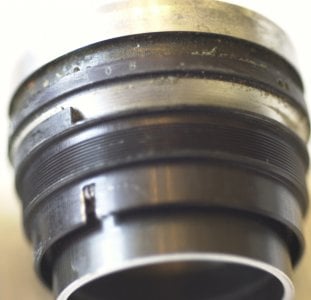
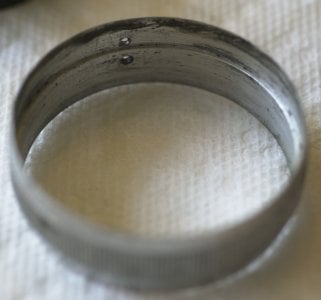
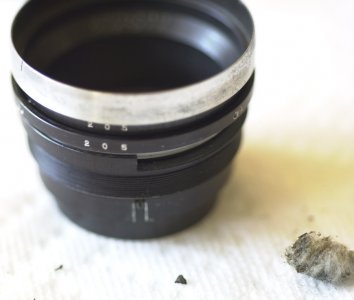
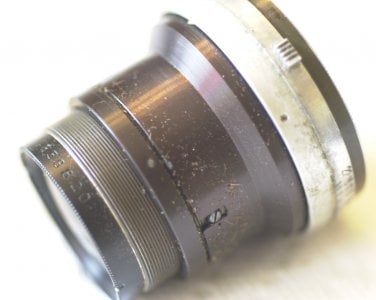
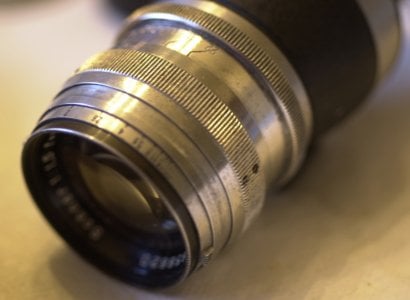





bluesky4013
YH
I bought a 5cm Sonnar and at first I didn’t know what it is just noticed it looks nothing like normal Sonnars. Chris from Skyllaney contacts me and I send the lens to clean and let him do some search on it.
In the end, Chris found out some interesting things about this lens. First, it is actually a 58mm lens, and the construction is different from any 58mm Sonnar from the 40’s 50’s he has ever seen. The glasses are pre war Schott formular and some parts are similar to the nickel era Sonnars. Some internal characteristics are identical to some rare LTM version Sonnars.
I’ll quote the message from Chris for the internal mechanism:
‘ There is a secondary brass helicoid system that pre-translates the 58mm EFL of the optical block down to a 51.6mm movement, before then further sending this translation to the non sloped but rotating rear RF cam.
Honestly, I have not seen this method ever used before, but it is ingenious.
Instead of more modern fork sliders that appeard in the 1960’s, or set screws which were present in the 1940-1950’s LTM lenses…
This lens uses precision ground dowel pins, to stabilize and prevent optical block rotation when focusing.
These ground dowel pins are a mere 0.025mm undersized for the equally precise, reamed hole to which they travel inside.’
But it still left some mystery question to me, some parts are just not quite good as normal zeiss standard. Second, the aperture indication on the DOF uses old standard like early leica lens, which Zeiss never uses, and it doesn’t even match the scale on the front ring aperture.
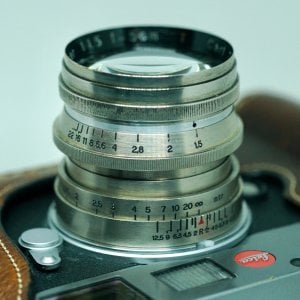
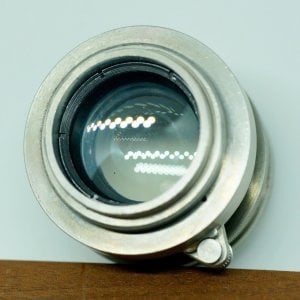
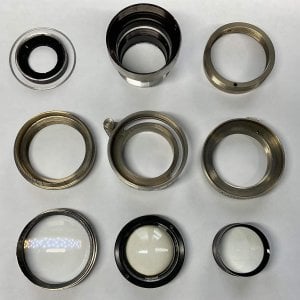
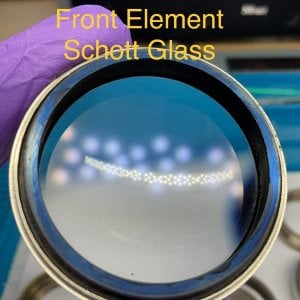
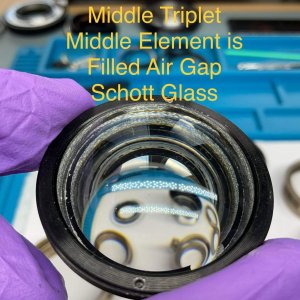
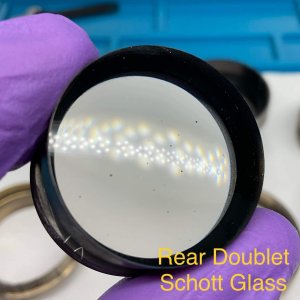
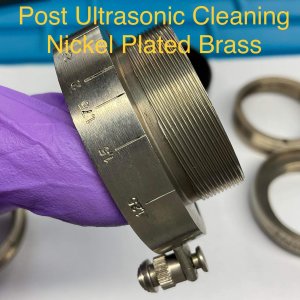
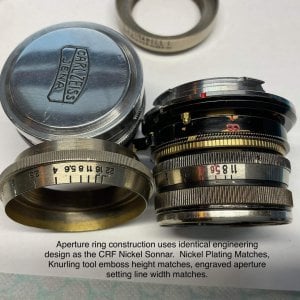
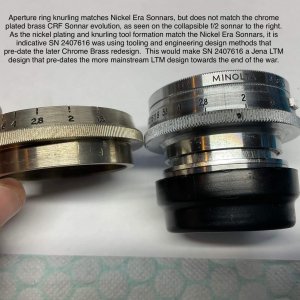
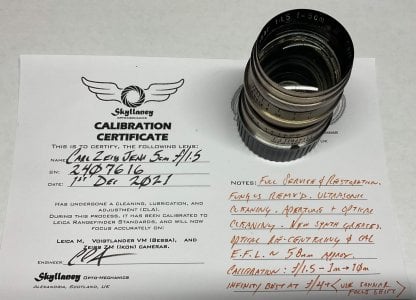

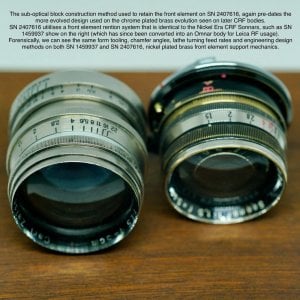
In the end, Chris found out some interesting things about this lens. First, it is actually a 58mm lens, and the construction is different from any 58mm Sonnar from the 40’s 50’s he has ever seen. The glasses are pre war Schott formular and some parts are similar to the nickel era Sonnars. Some internal characteristics are identical to some rare LTM version Sonnars.
I’ll quote the message from Chris for the internal mechanism:
‘ There is a secondary brass helicoid system that pre-translates the 58mm EFL of the optical block down to a 51.6mm movement, before then further sending this translation to the non sloped but rotating rear RF cam.
Honestly, I have not seen this method ever used before, but it is ingenious.
Instead of more modern fork sliders that appeard in the 1960’s, or set screws which were present in the 1940-1950’s LTM lenses…
This lens uses precision ground dowel pins, to stabilize and prevent optical block rotation when focusing.
These ground dowel pins are a mere 0.025mm undersized for the equally precise, reamed hole to which they travel inside.’
But it still left some mystery question to me, some parts are just not quite good as normal zeiss standard. Second, the aperture indication on the DOF uses old standard like early leica lens, which Zeiss never uses, and it doesn’t even match the scale on the front ring aperture.












Thankyou for posting this! Chris Emailed me about this lens a while ago- a real mystery lens. I also note that this F1.5 lens used a rear Doublet rather than the Triplet of most F1.5 Sonnars. There were some odd ones made, and I've seen a block diagram of a 1-3-2 5cm F1.5 Sonnar, and from the best I can tell- picked up one at random. The rear fixture is different from my Triplets. Lens is in poor condition, was heavily used. It is a Contax mount lens.
dexdog
Mentor
bluesky, thanks for posting, you have a very interesting lens. Sounds like Skyllaney is a pretty good forsenic pathologist for lenses.
AleG
Member
Hello, I finally received the lens I was speaking about a month ago, the CZJ Sonnar 5.8cm f1.5 in ltm
In the following days I will shot some pictures with it. Unfortunately, the rf ring is not calibrated on my M6
Thank you for the valuable informations on this thread!
In the following days I will shot some pictures with it. Unfortunately, the rf ring is not calibrated on my M6
Thank you for the valuable informations on this thread!
Attachments
-
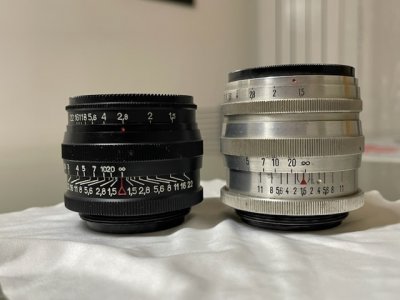 1FED0E45-B6FD-468D-8EA0-A42A48A9EECA.jpeg76.5 KB · Views: 10
1FED0E45-B6FD-468D-8EA0-A42A48A9EECA.jpeg76.5 KB · Views: 10 -
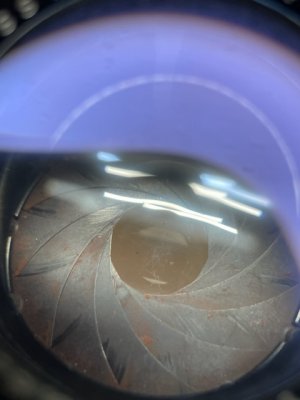 079C5C63-DED0-4F0F-BA03-6C593FD5AEB7.jpeg58.7 KB · Views: 10
079C5C63-DED0-4F0F-BA03-6C593FD5AEB7.jpeg58.7 KB · Views: 10 -
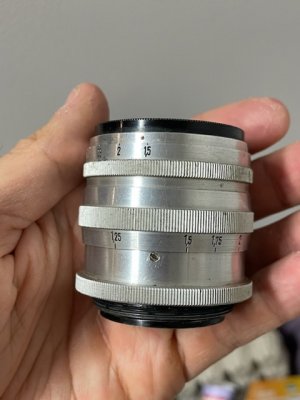 B31F060A-99E0-4E68-94D7-F90CB46726DC.jpeg75.5 KB · Views: 10
B31F060A-99E0-4E68-94D7-F90CB46726DC.jpeg75.5 KB · Views: 10 -
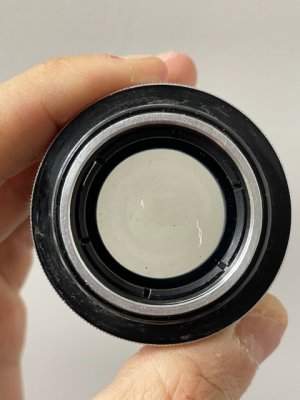 9E967F16-EAE8-4825-8A50-44E6342C6C86.jpeg80.9 KB · Views: 9
9E967F16-EAE8-4825-8A50-44E6342C6C86.jpeg80.9 KB · Views: 9 -
 666858BD-2E06-47EB-BC69-21D5ABA53CF2.jpeg82.6 KB · Views: 11
666858BD-2E06-47EB-BC69-21D5ABA53CF2.jpeg82.6 KB · Views: 11 -
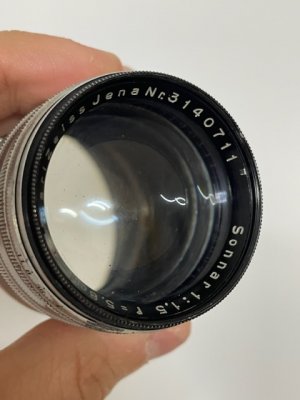 8FFAB80B-0005-42B8-9722-032FF4DE73BC.jpeg68.9 KB · Views: 11
8FFAB80B-0005-42B8-9722-032FF4DE73BC.jpeg68.9 KB · Views: 11 -
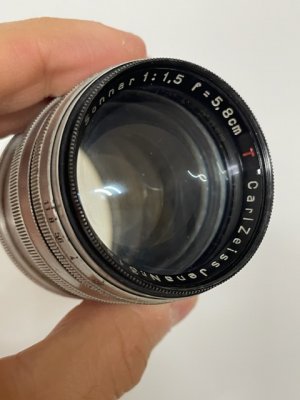 CDE6C71C-EAF0-46F2-A201-C03C10DCB2F0.jpeg74.4 KB · Views: 11
CDE6C71C-EAF0-46F2-A201-C03C10DCB2F0.jpeg74.4 KB · Views: 11
TenEleven
Well-known
I've been wanting to post about this for a while. Here's a rare one:
The 4cm Nickel era Biotar in original LTM mount. Housed in brass, not aluminum as the later lenses were.
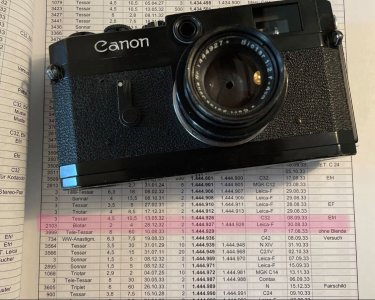
It was however sadly unbelievably filthy and the aperture was in a sorry state. The glass looked good. It had been coated at some point in its life. No indication thereof on the lens ring. Coating is amber/purple and hard and by my reckoning a lot more effective than the blueing of old.
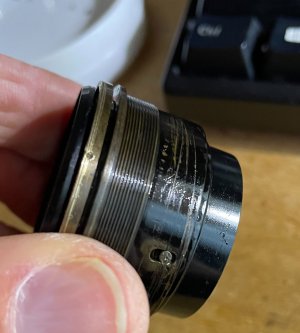
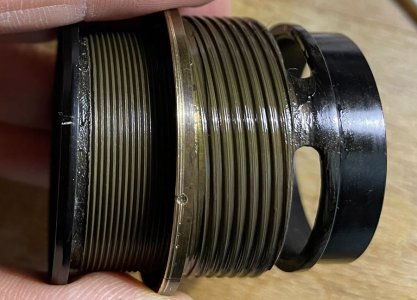
Typical Zeiss construction. These images were taken AFTER an initial wipe-down with an old shirt soaked in naphtha. Yes it was that filthy. One interesting bit is that the cut out slot of the outer ring determines the focus travel. There are no stop screws. Everything fits just so, which emphasizes the one off construction of this lens.
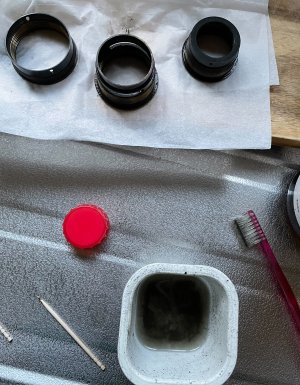
Cleaning the helical - so much filth came off them. Also the lens reeked... for some reason of a mix of old rotted grease AND perfume. Had someone tried to "spruce it up" for sale? We'll never know.
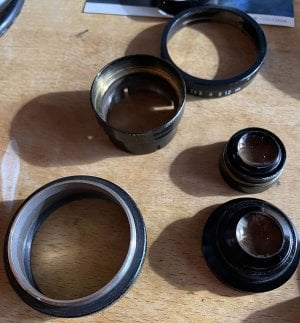
Optics and parts post cleaning. The optics also got a coat of fresh paint after this picture was taken.

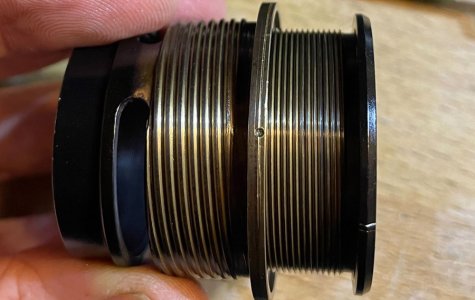
The helicals are now once again showing shiny brass and no longer smell. As it should be; re-assembly was fairly straight-forward. No shims for the lens either. The lens holders are Zeiss stamped with the last 6 digits as one would expect. No Zeiss numbers on the brass mount however.
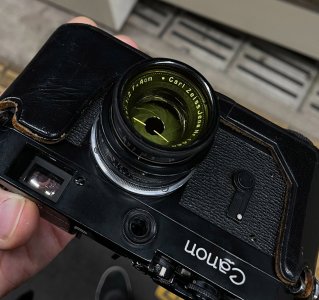
All back together with a period appropriate Zeiss Y1 push-on filter. Ready to shoot!
The 4cm Nickel era Biotar in original LTM mount. Housed in brass, not aluminum as the later lenses were.

It was however sadly unbelievably filthy and the aperture was in a sorry state. The glass looked good. It had been coated at some point in its life. No indication thereof on the lens ring. Coating is amber/purple and hard and by my reckoning a lot more effective than the blueing of old.


Typical Zeiss construction. These images were taken AFTER an initial wipe-down with an old shirt soaked in naphtha. Yes it was that filthy. One interesting bit is that the cut out slot of the outer ring determines the focus travel. There are no stop screws. Everything fits just so, which emphasizes the one off construction of this lens.

Cleaning the helical - so much filth came off them. Also the lens reeked... for some reason of a mix of old rotted grease AND perfume. Had someone tried to "spruce it up" for sale? We'll never know.

Optics and parts post cleaning. The optics also got a coat of fresh paint after this picture was taken.


The helicals are now once again showing shiny brass and no longer smell. As it should be; re-assembly was fairly straight-forward. No shims for the lens either. The lens holders are Zeiss stamped with the last 6 digits as one would expect. No Zeiss numbers on the brass mount however.

All back together with a period appropriate Zeiss Y1 push-on filter. Ready to shoot!
Attachments
xatnoc
Xatnoc
great story, congrats to all for putting this info together. Highly interesting!
S.H.
Picture taker
A bit late to the party concerning the 5.8cm sonnars...
I bought one 10years ago, out of curiosity. It is in Contax mount however, so probably not really useable : I don't do digital anymore, only film, so it would be on a M or a Contax. Infinity was mushy at f8, unusable under 8 meters, with a M adapter.
Here the history of mine, from the 1st owner:
In 1954-55 I bought a Kiev-camera and this lens in a then still private shop for photo-articles in Halle Saale (East-Germany) Kiev-cameras were then assembled illegally by employees of Zeiss-Jena in the Saalfeld-facctory from left-over parts from the years 1947-48 and sold on the black market or to some private shops with Sonnars 2,0 of original production smuggled out. The 1,5 lens I additional bought then was made of left-over wartimes-production of Sonnar 6cm lens blocks, made for bomb-sights originally, f-stops mechanics and blades added later. Black market only, too. It was a quite big, illegal "enterprise", later with real good mechanical parts and engraving, some with coated front lenses. Ended in the mid-fifties with many prison-sentences.
I bought one 10years ago, out of curiosity. It is in Contax mount however, so probably not really useable : I don't do digital anymore, only film, so it would be on a M or a Contax. Infinity was mushy at f8, unusable under 8 meters, with a M adapter.
Here the history of mine, from the 1st owner:
In 1954-55 I bought a Kiev-camera and this lens in a then still private shop for photo-articles in Halle Saale (East-Germany) Kiev-cameras were then assembled illegally by employees of Zeiss-Jena in the Saalfeld-facctory from left-over parts from the years 1947-48 and sold on the black market or to some private shops with Sonnars 2,0 of original production smuggled out. The 1,5 lens I additional bought then was made of left-over wartimes-production of Sonnar 6cm lens blocks, made for bomb-sights originally, f-stops mechanics and blades added later. Black market only, too. It was a quite big, illegal "enterprise", later with real good mechanical parts and engraving, some with coated front lenses. Ended in the mid-fifties with many prison-sentences.
Attachments
TenEleven
Well-known
Continuing the "Information you will not be able to get anywhere else!" thread... (thanks Brian!)
Another post, another Biotar. This time the 5.8cm f/2 - Post war black version. And just on cue as @S.H. talked about the very factory that in all likelihood made this. It's not in the Thiele. The original finished mount was supposed to be Practiflex. Lot of 1000. Practicaflex mount pitch is M42, which to my understanding later became the sort of de-facto standard for single lens reflex lenses for a good while.
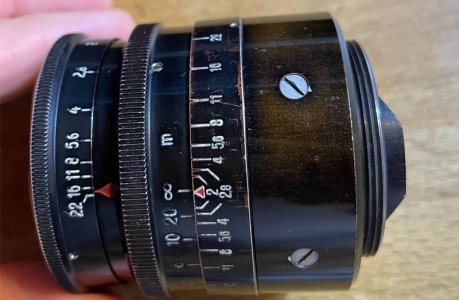
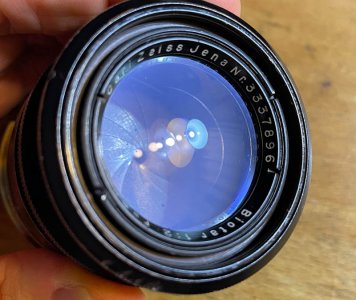
But, I digress, as you can see it's not in M42 mount (anymore) this is L39 or LTM if you may. Of note are the lovely patina (it's been used - we will get to why that is important) and the two big screws. We have seen this style of construction before. I think I posted it in this very sub-forum. Namely the re-manufactured 8.5cm f/2 Sonnar - also into LTM mount. For a laugh I (carefully!) interchanged the screws between the two. Perfect fit. Smoking gun? Probably not. But since screws back then were usually hand-made I reckon that's as good as a confirmation we are going to get 80 years later.
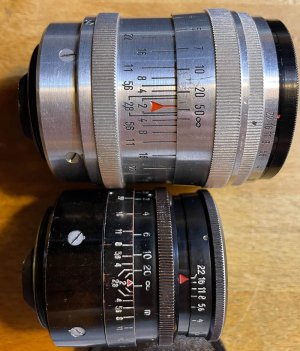
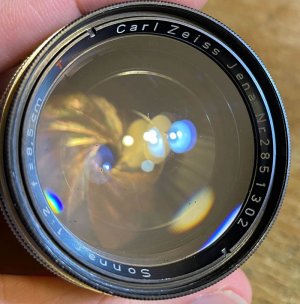
Anyway - the Biotar came to me - relatively (for its rarity) cheaply based on the fact that both the rangefinder AND the lens were out of whack, not just to each other but also independently. (The RF cam would not register infinity, the also failed to hit infinity, but moved at a different clip to the RF.)
Now looking at the other works this crew had done (the 5.8cm Sonnar, the 8.5cm Sonnar and ... I think the 5cm f/2 hourglass one I have ...) their work is usually the opposite of slipshod and the lenses were usually well calibrated. This and the aforementioned patina led me to assume that this lens rather either had been dropped (a bad scenario) or more likely a failed service attempt.
Knowing how important it is to thread the Helicals together JUST right in these Zeiss lenses plus the construction of the RF cam - which is unbeknownst to most on the internet (until now I would say) is adjustable(!) - I decided to take a gamble on it. When I got it the aperture was clean inside and the focus moved remarkably smoothly, just not correctly as I quickly confirmed.
To take this lens apart you should NOT touch the two big screws. Start from the aperture ring. Pull that off. Then the focus ring. Carefully. Since it also has the detents for the focus stops in it you do not want to warp it. Lastly the depth of field scale ring comes off. Underneath the depth of field scale ring are three more slotted screws. They hold in the entire lens and assembly.
While undoing these absolutely apply gentle but firm pressure on the lens head downwards - the whole thing is under spring tension - the return spring for the focus cam namely.
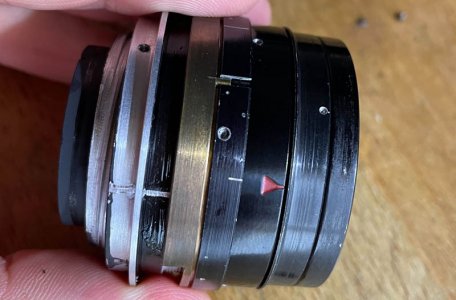
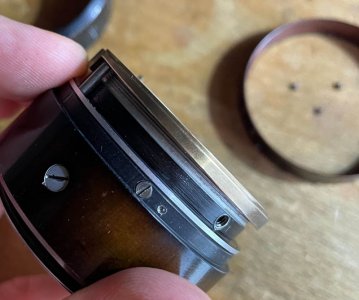
Pictured above (left) are the lens head (with the focus mechanism in place) and it's mate (right) which contains the mount, a spring and the focus cam, held in place by those two big screws. I am holding the rangefinder mechanism to it in the right picture. The mechanism is a simple sloped cam riding on a fine pitch helical. Brass on brass. A chromed brass rod rides in this slope and pushes on the focus cam. This is where our first issue was.
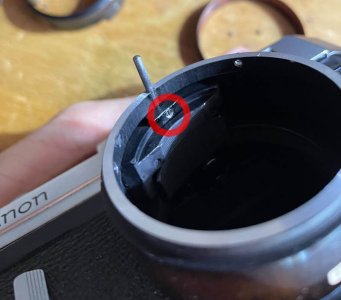
Circled in red is a headless grub screw. it links the chromed brass rod to the spring-driven rangefinder cam/tongue. You can undo this screw and either push the rod in (less deflection = moving the RF closer) or pull it out (more deflection from the sloped cam = RF moves toward (and past) infinity). These are minuscule adjustments and they are quite fiddly. But it is totally do-able. I had it on my trusty Canon RF for this purpose.
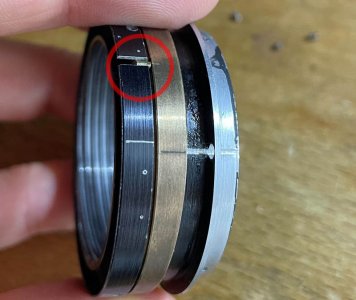
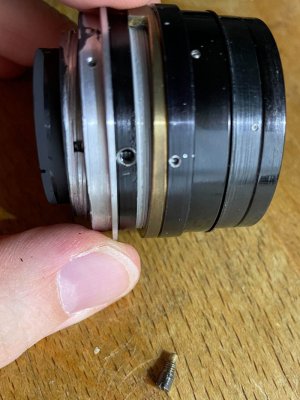
Right picture shows the lens head and sloped cam well. On the bottom of the right picture you can see the screw which is akin to the screws in the Russian/Sonnar lenses and basically makes sure that the lens head does not rotate as the helical (left picture) drives the lens head in and out. This construction along with the unprecedented access to Zeiss prototypes and raw materials makes me believe that some of these people were ex-Zeiss machinists almost certainly.
The second issue (lens not reaching infinity) was similarly a repair mistake. Likely the previous repairer had not removed the brass screw circled in red. Which allows you to more fully mate the black helical to the brass (RF cam driver) helical. It was off by one revolution. Since the black helical (as you can see on the right towards my hands) has coarse inner threads this makes quite a difference in focus! You can also see this mistake by the scratched manufacture marks not lining up as well.
Being off by one revolution meant of course that the index marks all line up - the lens looks "right" but will not work properly. My generic piece of advice is for Zeiss and Russian lenses to always find the helical start that lets you mate the two helical pieces to the maximum possible extent and then slowly back them up so you can get the screws in. In 90% of the cases this is the correct position.The other 10%? Lots of bad words get said and a lot of trial and error, I am afraid. Luckily this lens was of the 90%.
Sadly I have no optical block disassembly pictures as the early black Biotar 5.8cm/2 lenses are famously fiddly (Japanese w Google Translate to English) and since the previous repairer had at least done a good job with the aperture and glass I chose not to tempt fate this time. You can check the link for that info, with plenty of pictures to boot!
It is all back together and works well now. I hope you find this information useful.
I apologize for the middling quality of the pictures this time - I tried to make it up by explaining a bit more verbosely - I took these as personal memos just in case I had to put the lens back together as it was in case I could not resolve the issue, only later I realized the value of this information.
Another post, another Biotar. This time the 5.8cm f/2 - Post war black version. And just on cue as @S.H. talked about the very factory that in all likelihood made this. It's not in the Thiele. The original finished mount was supposed to be Practiflex. Lot of 1000. Practicaflex mount pitch is M42, which to my understanding later became the sort of de-facto standard for single lens reflex lenses for a good while.


But, I digress, as you can see it's not in M42 mount (anymore) this is L39 or LTM if you may. Of note are the lovely patina (it's been used - we will get to why that is important) and the two big screws. We have seen this style of construction before. I think I posted it in this very sub-forum. Namely the re-manufactured 8.5cm f/2 Sonnar - also into LTM mount. For a laugh I (carefully!) interchanged the screws between the two. Perfect fit. Smoking gun? Probably not. But since screws back then were usually hand-made I reckon that's as good as a confirmation we are going to get 80 years later.


Anyway - the Biotar came to me - relatively (for its rarity) cheaply based on the fact that both the rangefinder AND the lens were out of whack, not just to each other but also independently. (The RF cam would not register infinity, the also failed to hit infinity, but moved at a different clip to the RF.)
Now looking at the other works this crew had done (the 5.8cm Sonnar, the 8.5cm Sonnar and ... I think the 5cm f/2 hourglass one I have ...) their work is usually the opposite of slipshod and the lenses were usually well calibrated. This and the aforementioned patina led me to assume that this lens rather either had been dropped (a bad scenario) or more likely a failed service attempt.
Knowing how important it is to thread the Helicals together JUST right in these Zeiss lenses plus the construction of the RF cam - which is unbeknownst to most on the internet (until now I would say) is adjustable(!) - I decided to take a gamble on it. When I got it the aperture was clean inside and the focus moved remarkably smoothly, just not correctly as I quickly confirmed.
To take this lens apart you should NOT touch the two big screws. Start from the aperture ring. Pull that off. Then the focus ring. Carefully. Since it also has the detents for the focus stops in it you do not want to warp it. Lastly the depth of field scale ring comes off. Underneath the depth of field scale ring are three more slotted screws. They hold in the entire lens and assembly.
While undoing these absolutely apply gentle but firm pressure on the lens head downwards - the whole thing is under spring tension - the return spring for the focus cam namely.


Pictured above (left) are the lens head (with the focus mechanism in place) and it's mate (right) which contains the mount, a spring and the focus cam, held in place by those two big screws. I am holding the rangefinder mechanism to it in the right picture. The mechanism is a simple sloped cam riding on a fine pitch helical. Brass on brass. A chromed brass rod rides in this slope and pushes on the focus cam. This is where our first issue was.

Circled in red is a headless grub screw. it links the chromed brass rod to the spring-driven rangefinder cam/tongue. You can undo this screw and either push the rod in (less deflection = moving the RF closer) or pull it out (more deflection from the sloped cam = RF moves toward (and past) infinity). These are minuscule adjustments and they are quite fiddly. But it is totally do-able. I had it on my trusty Canon RF for this purpose.


Right picture shows the lens head and sloped cam well. On the bottom of the right picture you can see the screw which is akin to the screws in the Russian/Sonnar lenses and basically makes sure that the lens head does not rotate as the helical (left picture) drives the lens head in and out. This construction along with the unprecedented access to Zeiss prototypes and raw materials makes me believe that some of these people were ex-Zeiss machinists almost certainly.
The second issue (lens not reaching infinity) was similarly a repair mistake. Likely the previous repairer had not removed the brass screw circled in red. Which allows you to more fully mate the black helical to the brass (RF cam driver) helical. It was off by one revolution. Since the black helical (as you can see on the right towards my hands) has coarse inner threads this makes quite a difference in focus! You can also see this mistake by the scratched manufacture marks not lining up as well.
Being off by one revolution meant of course that the index marks all line up - the lens looks "right" but will not work properly. My generic piece of advice is for Zeiss and Russian lenses to always find the helical start that lets you mate the two helical pieces to the maximum possible extent and then slowly back them up so you can get the screws in. In 90% of the cases this is the correct position.The other 10%? Lots of bad words get said and a lot of trial and error, I am afraid. Luckily this lens was of the 90%.
Sadly I have no optical block disassembly pictures as the early black Biotar 5.8cm/2 lenses are famously fiddly (Japanese w Google Translate to English) and since the previous repairer had at least done a good job with the aperture and glass I chose not to tempt fate this time. You can check the link for that info, with plenty of pictures to boot!
It is all back together and works well now. I hope you find this information useful.
I apologize for the middling quality of the pictures this time - I tried to make it up by explaining a bit more verbosely - I took these as personal memos just in case I had to put the lens back together as it was in case I could not resolve the issue, only later I realized the value of this information.
Räuber
Established

Zeiss Ikon Contax III mit Sonnar1:1,5 f=5cm Defekt / Ersatzteile | eBay
Entdecken Sie Zeiss Ikon Contax III mit Sonnar1:1,5 f=5cm Defekt / Ersatzteile in der großen Auswahl bei eBay. Kostenlose Lieferung für viele Artikel!
www.ebay.de
I wonder about the time of WWII and if there might be some Sonnars we do not know because they where housed for military use. This strange one does not match any Sonnar lens I have seen so far. The serial number is from an ARRI Sonnar batch but it seems to be a Contax lens.
If you look at the aperture ring it is very different from any other Sonnar 5cm F1.5 lens. And it features a double aperture scale that was introduced after the war by Zeiss-Opton. It looks like it was made for photographing or filming in rough environments. I noticed similar kind of Sonnars before.

CARL ZEISS JENA Objektiv Lens SONNAR 2/50 f=5cm - Vorkrieg / pre-war | eBay
CARL ZEISS JENA SONNAR 2/50 OBJEKTIV -. Blende - Blende funktioniert einwandfrei -. = sehr guter Zustand, minimale Gebrauchsspuren / excellent condition, nearly no traces of wear. = guter Zustand, normale Gebrauchsspuren / good condition, normal traces of wear.
www.ebay.de
This Sonnar 5cm F2 looks like it was build as a tank too. I think I have seen a similar F1.5 one in the past. I dismissed those ones as custom workshop made but maybe they are Zeiss-made? Any opinions?
I noticed that especially for the Sonnar 5cm F1.5 there are a lot of production batches during WWII that I have never seen a single lens of: 47, 48, 49, (50 <- the ARRI batch I mentioned), 53, 55, 57, 59, 60, 62, 66, 68, 70, 71. Most late WWII Sonnars only come from 3 batches 58, 67 and 69 and a lot of them are transition and fake lenses. I wonder what happened to all those thousands of Sonnar lenses created between 1942 - 1945?
Last edited:
The first Auction shows an Arriflex mount Sonnar with the Truncated rear triplet that has been hacked into a mount to fit a Contax. The image circle is reduced from that of a regular Sonnar. The Second lens- someone made a hacked mount for the Sonnar, fit just the optical block into it. These look like something I do when Hacking a lens into another mount, such as my Leitz Varob- same as an Elmar 5cm F3.5, but in an Enlarger mount. Mine is now in an RF coupled M-Mount. I had to use a Marker for the F-Stops.
Zeiss Ikon Contax III mit Sonnar1:1,5 f=5cm Defekt / Ersatzteile | eBay
Entdecken Sie Zeiss Ikon Contax III mit Sonnar1:1,5 f=5cm Defekt / Ersatzteile in der großen Auswahl bei eBay. Kostenlose Lieferung für viele Artikel!www.ebay.de
I wonder about the time of WWII and if there might be some Sonnars we do not know because they where housed for military use. This strange one does not match any Sonnar lens I have seen so far. The serial number is from an ARRI Sonnar batch but it seems to be a Contax lens.
If you look at the aperture ring it is very different from any other Sonnar 5cm F1.5 lens. And it features a double aperture scale that was introduced after the war by Zeiss-Opton. It looks like it was made for photographing or filming in rough environments. I noticed similar kind of Sonnars before.

CARL ZEISS JENA Objektiv Lens SONNAR 2/50 f=5cm - Vorkrieg / pre-war | eBay
CARL ZEISS JENA SONNAR 2/50 OBJEKTIV -. Blende - Blende funktioniert einwandfrei -. = sehr guter Zustand, minimale Gebrauchsspuren / excellent condition, nearly no traces of wear. = guter Zustand, normale Gebrauchsspuren / good condition, normal traces of wear.www.ebay.de
This Sonnar 5cm F2 looks like it was build as a tank too. I think I have seen a similar F1.5 one in the past. I dismissed those ones as custom workshop made but maybe they are Zeiss-made? Any opinions?
I noticed that especially for the Sonnar 5cm F1.5 there are a lot of production batches during WWII that I have never seen a single lens of: 47, 48, 49, (50 <- the ARRI batch I mentioned), 53, 55, 57, 59, 60, 62, 66, 68, 70, 71. Most late WWII Sonnars only come from 3 batches 58, 67 and 69 and a lot of them are transition and fake lenses. I wonder what happened to all those thousands of Sonnar lenses created between 1942 - 1945?
SO- one of a kind Hack Jobs, by someone like me- done long ago.
Räuber
Established
Thank you Brian. Hacked is a good word for a lot of those WWII Sonnar lenses. It is a lot shorter than Frankenstein. 😄
About that missing lenses from WWII... I looked up my Excel sheets again and I think it is fine. There is no major issue here. It is WWII...
About that missing lenses from WWII... I looked up my Excel sheets again and I think it is fine. There is no major issue here. It is WWII...
- 47, 48, 49 = prototype batches of single or 2 lenses to test Super Parvo or ARRI
- 50 = 100 ARRI (1 hacked seen)
- 53 = 600 Contax
- 55 = 300 ARRI
- 57 = 100 Super Parvo
- 59 = 1 Contax (maybe prototype)
- 60 = 150 ARRI
- 62 = 800 Contax
- 66 = 60 ARRI
- 68 = 2000 Leica (1 seen)
- 70 = 1000 Contax
- 71 = 100 Contax
The strangest Sonnar I own, and is missing in Thiele- 2,767,816. Contax Mount 5cm F1.5 Sonnar "T". Bought dirt cheap, glass is a disaster, would need all surfaces polished. But for $65, no complaints. It appears to be a 1-3-2, 6 elements in three groups- rear group is a doublet. This block diagram appears on Marco's site for an F1.5 never put into production.
TenEleven
Well-known
That's interesting! I assume you counted the reflections to arrive at these figures?
I guess it makes sense, since nearing the end of the war the material shortages must have been severa and Zeiss was emptying out the drawers and bins for anything to make lenses out of in order to meet the designated quotas.
I guess it makes sense, since nearing the end of the war the material shortages must have been severa and Zeiss was emptying out the drawers and bins for anything to make lenses out of in order to meet the designated quotas.
f.hayek
Well-known
The strangest Sonnar I own, and is missing in Thiele- 2,767,816. Contax Mount 5cm F1.5 Sonnar "T". Bought dirt cheap, glass is a disaster, would need all surfaces polished. But for $65, no complaints. It appears to be a 1-3-2, 6 elements in three groups- rear group is a doublet.
What do you mean by, “the strongest” if the glass is described by you as a, “disaster”?
I wrote "The Strangest", but- you gave me an opening to Babble On about it. The individual elements in the rear Doublet would be Stronger Power than individual elements in the traditional triplet used on the 5cm F1.5. Thus Strange and Strong, all due to the rear group.What do you mean by, “the strongest” if the glass is described by you as a, “disaster”?
Share:
-
This site uses cookies to help personalise content, tailor your experience and to keep you logged in if you register.
By continuing to use this site, you are consenting to our use of cookies.


